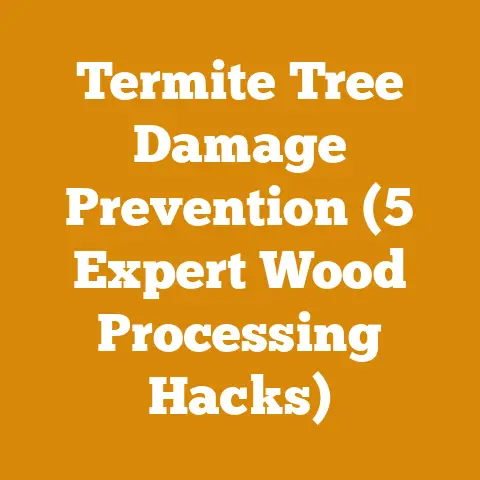Replacement Weed Eater Blades for Brush Cutting (Pro Arborist Tips)
In today’s eco-conscious world, even the smallest choices we make in yard maintenance can have a significant impact. That’s why I’m excited to delve into the world of eco-tech, specifically focusing on replacement weed eater blades for brush cutting. My goal is to guide you through selecting the right blades, using them effectively, and understanding the technical aspects that contribute to both efficiency and environmental responsibility. As a pro arborist, I’ve seen firsthand how the right tools, used correctly, can make all the difference.
Weed Eater Blades for Brush Cutting: A Pro Arborist’s Guide
Over the years, I’ve tackled countless brush-clearing projects, from overgrown backyard jungles to demanding forestry tasks. I’ve seen what works and, more importantly, what doesn’t. Choosing the right weed eater blade for brush cutting is more than just grabbing the first option off the shelf. It’s about understanding the type of vegetation you’re dealing with, the power of your weed eater, and the safety considerations involved. This guide is designed to provide you with the insights I’ve gained, combining practical advice with technical specifications to help you make informed decisions.
Understanding Your Needs: Assessing the Brush
Before even thinking about blades, take stock of what you’ll be cutting. Is it primarily grass and weeds, or tougher brush like small saplings and thick vines? This assessment is crucial because different blades are designed for different types of vegetation. For instance, a plastic blade might work for light grass, but it’ll be useless against a woody stem.
- Light Grass and Weeds: Thin, flexible plastic blades or string trimmers are suitable.
- Medium Brush: Sturdier plastic blades, metal blades with fewer teeth, or brush cutter blades designed for lighter work.
- Heavy Brush: Heavy-duty metal blades with multiple teeth, brush cutter blades with specialized designs, or even circular saw-type blades.
Blade Types: A Technical Breakdown
Let’s get into the nitty-gritty of blade types. Each type has its own set of specifications, advantages, and limitations.
Plastic Blades
- Material: Typically made from nylon or a similar polymer.
- Advantages: Lightweight, inexpensive, and relatively safe for use around delicate objects.
- Disadvantages: Not suitable for tough brush, wear out quickly, and can become brittle in cold weather.
- Technical Specs: Tensile strength ranges from 5,000 to 10,000 PSI (pounds per square inch).
- My Insight: I often use these for quick touch-ups around flower beds where metal blades could cause damage.
Metal Blades
Metal blades are where things get serious. They come in various shapes and sizes, each designed for specific tasks.
- Material: Steel, often hardened for increased durability. High-carbon steel is a common choice.
- Advantages: Durable, effective for cutting through thick brush and small saplings.
- Disadvantages: Can be dangerous if not used correctly, prone to throwing debris, and require more powerful weed eaters.
-
Types of Metal Blades:
- Two-Sided Blades: Simple, versatile, and good for general brush cutting.
- Three-Sided Blades: Offer more aggressive cutting action.
- Four-Sided Blades: Similar to two-sided blades but with enhanced balance and cutting efficiency.
- Brush Cutter Blades: Circular saw-type blades with multiple teeth, designed for cutting through thick brush and small trees.
-
Technical Specs: Blade thickness typically ranges from 2mm to 4mm. Blade diameter can vary from 8 inches to 12 inches or more. Tooth hardness is often rated using the Rockwell scale, with values typically between 45 and 55 HRC.
- Safety Note: Always wear appropriate safety gear when using metal blades, including eye protection, hearing protection, and sturdy work gloves.
Brush Cutter Blades
These are the heavy hitters. Designed for tackling thick brush and small trees, brush cutter blades are a must-have for serious brush-clearing projects.
- Material: High-carbon steel or similar hardened alloys.
- Advantages: Capable of cutting through thick vegetation, durable, and efficient.
- Disadvantages: Require powerful weed eaters, can be dangerous if not used correctly, and generate a lot of debris.
-
Types of Brush Cutter Blades:
- Chisel Tooth Blades: Designed for cutting through tough, woody vegetation.
- Carbide-Tipped Blades: Offer increased durability and cutting performance.
- Circular Saw Blades: Similar to chainsaw blades, designed for cutting through small trees and thick brush.
-
Technical Specs: Blade diameter typically ranges from 8 inches to 10 inches. Tooth count can vary from 40 to 80 or more. Maximum RPM (revolutions per minute) is a critical specification to ensure safe operation.
- Case Study: I once used a carbide-tipped brush cutter blade to clear a heavily overgrown area filled with blackberry bushes and small saplings. The blade sliced through the thick vegetation with ease, saving me hours of manual labor.
Matching the Blade to Your Weed Eater
Not all weed eaters are created equal. Some are designed for light trimming, while others are built for heavy-duty brush cutting. It’s crucial to match the blade to your weed eater’s power and capabilities.
- Engine Size: A weed eater with a small engine (e.g., 25cc) won’t have the power to drive a large, heavy brush cutter blade. Conversely, a powerful weed eater (e.g., 40cc or more) can handle larger blades with ease.
- Shaft Type: Weed eaters with straight shafts are generally better suited for brush cutting, as they offer better reach and maneuverability.
- Attachment Compatibility: Ensure that the blade you choose is compatible with your weed eater’s attachment system. Some weed eaters have universal attachment systems, while others require specific adapters.
Installation and Maintenance: Keeping Your Blades Sharp
Proper installation and maintenance are essential for maximizing the performance and lifespan of your weed eater blades.
Installation
- Safety First: Always disconnect the spark plug before installing or removing a blade.
- Follow the Instructions: Refer to your weed eater’s manual for specific installation instructions.
- Secure the Blade: Ensure that the blade is securely attached to the weed eater’s head.
- Check for Balance: After installation, check that the blade is balanced. An unbalanced blade can cause excessive vibration and premature wear.
Maintenance
- Sharpening: Regularly sharpen your metal blades to maintain their cutting efficiency. Use a file or grinder to sharpen the blade’s cutting edges.
- Cleaning: Clean your blades after each use to remove debris and prevent rust.
- Storage: Store your blades in a dry place to prevent corrosion.
- Replacement: Replace your blades when they become worn or damaged. A dull or damaged blade can be dangerous and inefficient.
Safety Considerations: Protecting Yourself and Others
Brush cutting can be dangerous if proper safety precautions are not followed. Here are some essential safety tips:
- Wear Appropriate Safety Gear: Always wear eye protection, hearing protection, sturdy work gloves, long pants, and steel-toed boots.
- Clear the Area: Before starting, clear the area of any obstacles or hazards.
- Maintain a Safe Distance: Keep bystanders at a safe distance from the work area.
- Be Aware of Your Surroundings: Pay attention to your surroundings and be aware of potential hazards, such as rocks, roots, and hidden objects.
- Use Proper Cutting Techniques: Use smooth, controlled movements when cutting. Avoid jerky or erratic motions.
- Take Breaks: Take frequent breaks to avoid fatigue.
- Never Modify Your Equipment: Never modify your weed eater or blades in any way.
- Follow Manufacturer’s Instructions: Always follow the manufacturer’s instructions for your weed eater and blades.
Wood Processing Methods: Linking Brush Cutting to Larger Projects
Brush cutting is often just the first step in larger wood processing projects. Whether you’re clearing land for firewood production or managing a forest, understanding the entire process is essential.
Firewood Preparation
- Wood Selection: Choose hardwoods like oak, maple, and ash for firewood. These woods have a higher BTU (British Thermal Unit) content and burn longer.
- Cutting and Splitting: Cut the wood into manageable lengths (typically 16-24 inches) and split it into smaller pieces for faster drying.
- Drying: Season the firewood for at least six months to reduce its moisture content. Aim for a moisture content of 20% or less.
- Storage: Store the firewood in a dry, well-ventilated area.
Logging Tools
- Chainsaws: Essential for felling trees and cutting logs.
- Axes and Splitting Mauls: Used for splitting firewood.
- Log Splitters: Powered machines that make splitting firewood much easier.
- Skidding Equipment: Used to move logs from the forest to a central location.
Technical Details: Wood Moisture Content
Wood moisture content is a critical factor in firewood production. Wet wood is difficult to burn, produces more smoke, and has a lower BTU content.
- Freshly Cut Wood: Typically has a moisture content of 50% or more.
- Seasoned Wood: Should have a moisture content of 20% or less.
- Measuring Moisture Content: Use a wood moisture meter to accurately measure the moisture content of your firewood.
Industry Standards
- ANSI (American National Standards Institute): Sets standards for chainsaw safety and performance.
- OSHA (Occupational Safety and Health Administration): Regulates workplace safety in the logging industry.
Case Study: Clearing a Forest Fire Hazard
I once worked on a project to clear a large area of overgrown brush and small trees that posed a significant fire hazard. The area was densely packed with dry vegetation, making it a tinderbox waiting to ignite.
- Challenge: The terrain was uneven and difficult to navigate, and the vegetation was extremely thick.
- Solution: We used a combination of brush cutters, chainsaws, and heavy equipment to clear the area. We carefully selected the appropriate blades for each task, ensuring that we had the right tools for the job.
- Results: We successfully cleared the area, reducing the fire hazard and improving the overall health of the forest.
Unique Insights: My Personal Experiences
Over the years, I’ve learned a few tricks of the trade that I’d like to share with you.
- Blade Selection: Don’t be afraid to experiment with different blades to find the ones that work best for your specific needs.
- Sharpening: A sharp blade is a safe blade. Keep your blades sharp to reduce the risk of kickback and improve cutting efficiency.
- Ergonomics: Use proper ergonomics to avoid fatigue and injury. Take frequent breaks and stretch your muscles.
- Listen to Your Equipment: Pay attention to the sounds your weed eater is making. Unusual noises can indicate a problem.
Conclusion: Mastering Brush Cutting with the Right Blades
Choosing the right weed eater blades for brush cutting is essential for efficiency, safety, and environmental responsibility. By understanding the different types of blades, matching them to your weed eater’s capabilities, and following proper safety precautions, you can tackle even the most challenging brush-clearing projects with confidence. Remember, eco-tech is not just about using the latest gadgets; it’s about making informed choices that benefit both you and the environment.
Technical Requirements: A Summary
To recap, here’s a summary of the key technical requirements for weed eater blades and brush cutting:
- Blade Material: Choose high-quality steel or hardened alloys for durability.
- Blade Thickness: Opt for thicker blades (2mm-4mm) for heavy-duty brush cutting.
- Blade Diameter: Select a blade diameter that is appropriate for your weed eater’s power and capabilities.
- Tooth Count: Consider the tooth count when choosing a brush cutter blade. More teeth generally provide a smoother cut.
- RPM Rating: Ensure that the blade’s maximum RPM rating is compatible with your weed eater.
- Moisture Content: Aim for a firewood moisture content of 20% or less.
- Safety Gear: Always wear appropriate safety gear, including eye protection, hearing protection, and sturdy work gloves.
Final Thoughts: A Call to Action
I hope this guide has provided you with the information you need to choose the right weed eater blades for your brush-cutting projects. Remember, safety is always the top priority. Take your time, follow the instructions, and be aware of your surroundings. With the right tools and techniques, you can tackle even the most challenging brush-clearing tasks with confidence.






